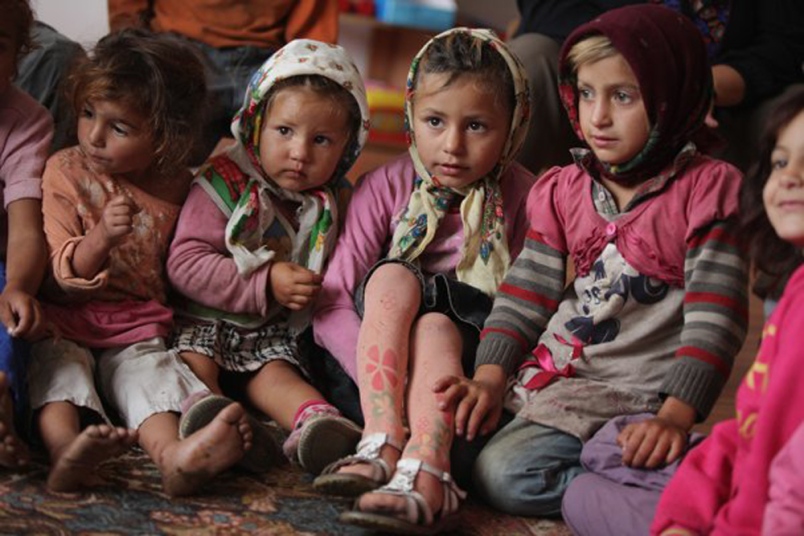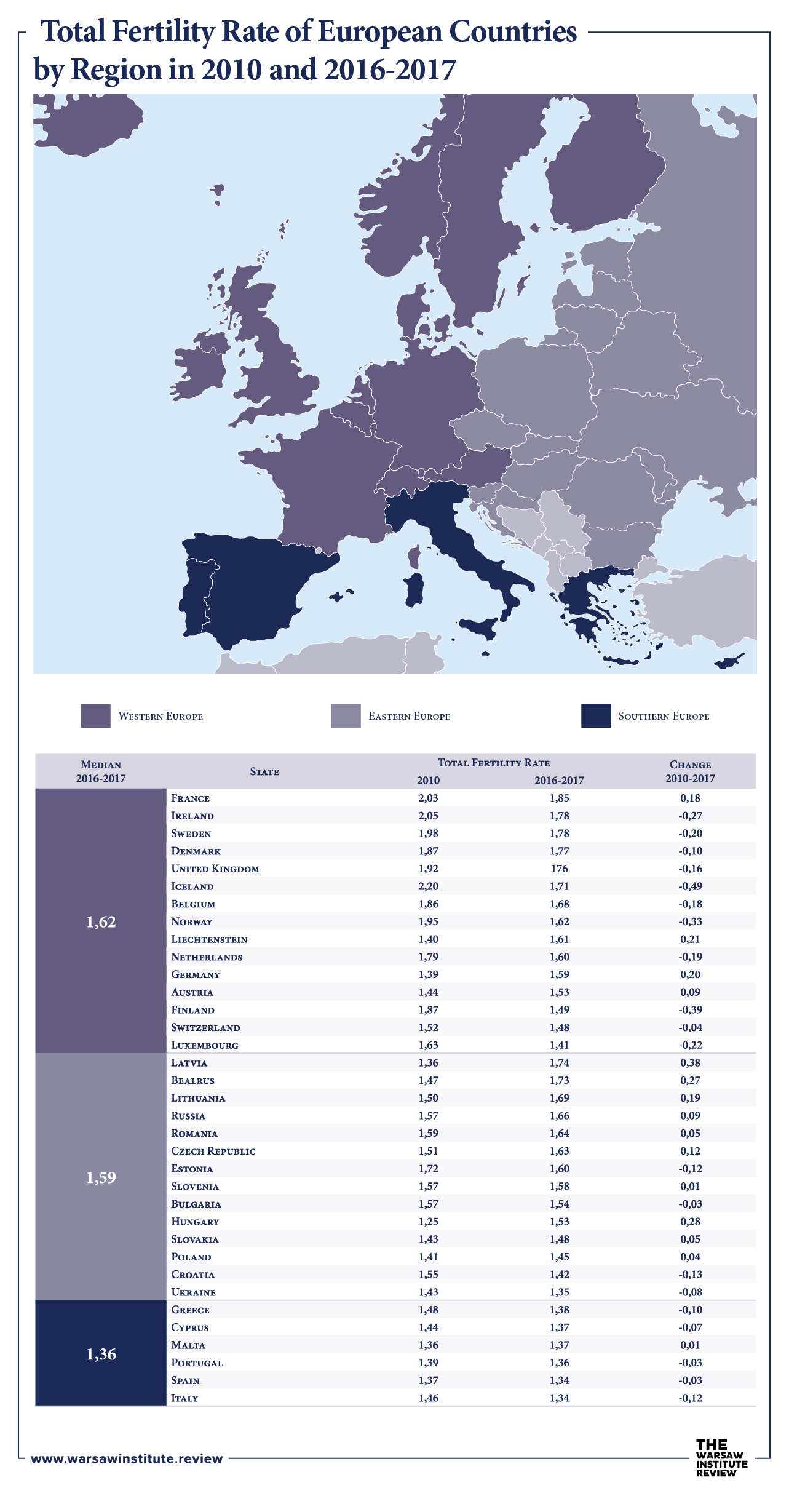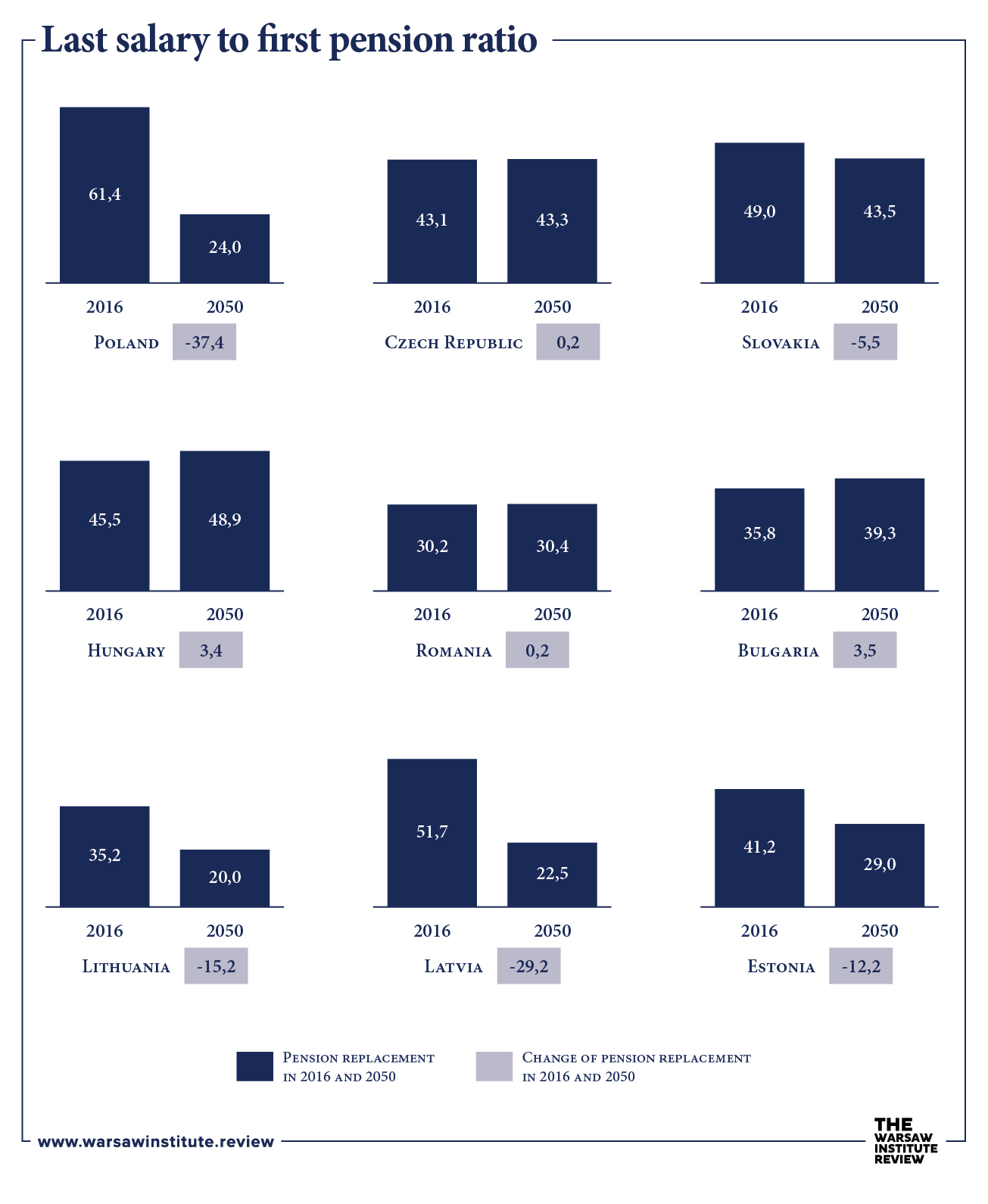THE WARSAW INSTITUTE REVIEW
Date: 4 December 2019 Author: Mateusz Łakomy
The demographic future of Eastern Europe
The demographic outlook for Eastern Europe has a bittersweet taste. The region may suffer considerably from low fertility rates, but it may manage to get around the biggest changes associated with migration.

Is demography destiny?
Predicting the future is thought to be a domain of magicians and fortune-tellers, who try to read the future through the stars or crystal balls. Modern day fortune-tellers, however, include demographers who use completely different instruments – statistical models and in-depth scientific research on population trends.
Statistical population forecasting is a complex task, but with some analytical effort, it is feasible, and importantly, reliable. It is carried out by many institutions such as the UN, the World Bank, Eurostat, the national statistical institutes, and various independent scientific centers. Based on assumptions about fertility, migration, and longevity, they issue estimates about the expected evolution of population size.
What helps with forecasting is the acknowledgement that changes in demography occur slowly; when a significant demographic momentum occurs. In 2019, we can say that we already know the number of parents of children born in 2040 because almost all of them have already been born – which is a fundamental basis for the number of births of that year. As far as the average family size is concerned, it is subject to long-term trends, the results of which are predictable. If no dramatic, almost revolutionary external intervention happens in the form of new stimuli, the predicted number of children born can be statistically modeled.
Although dramatic changes cannot be predicted, it is to be expected that some will happen – the only unknown thing is whether they will stimulate fertility or lead to its decline. Several revolutions happened in the second half of the 20th century, two of which include: the contraceptive revolution after the invention of the contraceptive pill and the revolution in the value system, consisting in the spread of individualism, clearly had a negative impact on the birth rate, leading to significant corrections in earlier predictions.
Demographic projections do not, therefore, have to necessarily be treated as an incontestable forecast. However, they must be treated as a warning signal of what can happen if there is no significant intervention. In this respect, they are a call to action for politicians whose determined action may lead to diametrically different population sizes.
Eastern Europe is a region having its demographic specificity. Its experience of recent decades has been shaped by social and economic transformation after the collapse of the communist system, the related developmental delay, accession to the European Union (for most countries), and the absorption – to a varying extent in individual countries – of Western cultural trends. These factors led to a decline in fertility rates and specific migratory dynamics, which, in almost every country in the region, led to a decline in fertility rates after the collapse of the communist system.
According to demographic projections, there will be a further decline in population size. For the purpose of this article, the United Nations’ demographic projections from June 2019 until 2100 were used in two variants: standard, assuming the current demographic indicators will remain unchanged, and probabilistic, resulting from the calculation of differentiated scenarios based on the analysis of overlapping differentiated trends. In both scenarios, the projected population of Eastern Europe will fall by more than 25%, respectively, and by 40%, if nothing changes. These are different trends than in Western Europe, where the probabilistic variant predicts a nearly 4% increase in population size. Trends in Southern Europe show even deeper declines than in Eastern Europe, with a standard variant exceeding 50% of the 2019 population.
Exhibit 1
Projection of the changes in the European population, 2019–2100, in million people and in %.
Demographers expect all countries in the Eastern European region to be more or less affected by a decline in population. Projections are rather pessimistic for Bulgaria, Ukraine, Lithuania, and Poland, which in the standard (unchanged) variant lose almost 60% of their current population, while in the probabilistic variant almost always above 40%. Slightly better projections are forecast for Romania, Latvia, and Estonia. In this context, slighter, but still deep falls are expected in Hungary, Slovakia and Belarus, and even less dramatic future is predicted for Russia, whose population losses should not significantly exceed 25%. A separate category is a situation in the Czech Republic, which is the only one in the probabilistic variant to have an almost untouched population.
Exhibit 2
Projection of changes in the population of Eastern European countries, 2019–2100, in million people and in %.
Since demographic projections are, in fact, the art of interpreting trends, the question is what demographic trends the countries of Eastern Europe are subject to. Understanding them will help to understand better what demographic fate awaits the countries of the region in the future.

The End of the East-West Divide?
Eastern Europe has long been different from Western Europe in terms of fertility. Social and economic changes beginning the decline of the formerly universally high fertility rates began in Western Europe as early as the end of the 18th century. They only reached Eastern Europe at the end of the 19th century, and in the first half of the century, they spread slowly and not in all regions, resulting in maintaining significantly higher fertility rates.
By creating a barrier against the diffusion of the effects of the cultural revolution, popularization of many contraceptive methods, and promotion of professional aspirations of women, the period of communism was encouraging the preservation of relatively higher fertility rates – at a time when their levels in the West were nearly at an all-time low. The transformation period after the fall of communism, however, was marked by the opposite trends – the fertility rate of Eastern European countries plummeted, reaching its lowest levels at the beginning of the 21st century, while the fertility rate of many Western countries – with the single exceptions of Southern countries and German-speaking countries – started to rise again.
However, a change occurred in the second decade of the 21st century. The fertility rate in most Eastern European countries has started to rise, while in many Western European countries, it has fallen slightly again. This has led to the convergence of fertility rates between these regions. However, fertility rates remained low among the countries of the South. As a result, a new demographic divide in Europe between the North and the South is emerging before our very eyes, with the border at the top of the mountain ranges – the Pyrenees, the Alps, and South to the Pindus and the Rhodopes.
Support Us
If content prepared by Warsaw Institute team is useful for you, please support our actions. Donations from private persons are necessary for the continuation of our mission.
Exhibit 3
European countries by regions according to the TFR fertility rate in 2010 and 2016–17
Poorer Than Their Parents?
There is one obvious consequence of the decrease in the fertility rate – demographic aging. This means an increase in the percentage of older people, including those at retirement age, at the expense of younger people – the employed and children. To preserve fiscal sustainability given the pressure to increase pension expenditure, policymakers will be faced with one of three options: reducing the population of pensioners and increasing the number of employees, e.g., by increasing the retirement age or activating the so-far unemployed, reducing pension, or mobilizing additional resources.
For the countries of the European Union, the European Commission has prepared forecasts of the impact of current demographic trends and the maintenance of current rules of social policies on budget expenditures and benefits for pensioners. The influence on the level of pensions in Eastern European countries measured by the so-called replacement rate – the ratio of the first pension of those who retire in a given year over the average wage at retirement – will be differentiated. Demographic dynamics will not harm retired Bulgarians, Hungarians, Czechs, and Romanians who can even expect some improvement in replacement rates. This is particularly important for Romanians and Bulgarians who are currently starting from low positions. A slight reduction is expected in Slovakia. The countries most at risk include Lithuania, Latvia, Poland, and Estonia, where replacement rates will fall to less than 1/3, and usually even less than 1/4, of the last salary. Estimates indicate that about 70% of Poles born at the turn of the 1970s and 1980s will receive only a minimum pension . What is particularly worth noting is the scale of the fall in the replacement rate for Poland and Latvia – which will fall by more than half.
Exhibit 4
Gross replacement rate at retirement in 2016 and 2050 in %.
However, can we believe scenarios that predict significant decreases in the replacement rate? As the number of retired people in democratic societies increases, their political importance is expected to increase. It will be more than tempting for politicians to win their support by limiting pension falls. The means for this may be to obtain funds by redirecting them from other areas of public expenditure, which would lead to the crowding-out effect. These sources of funding can be, for instance, other significant domains of public spendings – such as national defense, schooling, education, or investment – which would, at the same time, jeopardize security and productivity growth.

The second source of funds for pension expenditure is additional taxation of employees, limiting their disposable income. With growing consumer aspirations, it may increase the impact on the decline in satisfaction with the standard of living which could stimulate an eventual spiral effect of further reduction in the number of children – in line with the mechanism of the “low fertility trap” – if I do not have enough money for myself, why generate another big expense in the form of a child?
A New Face of Eastern Europe?
Migration is a characteristic sign of our times. It is the most difficult element to forecast in demographic projections due to a high dependence on internal changes in sending countries and immigration policies of host countries. Even determining what the scale of historic migrations is problematic – it is not surprising, therefore, that the most precise answer to the question of what migration will be like in the future is “unknown.”
In the future, however, migrations will certainly occur, and for the needs of population projection, some accepted assumptions should be made. The UN bases its projections until the end of the 21st century on historical trends. They present estimates of net migration – the difference between immigration and emigration. According to this calculation, all regions of Europe are to be net immigration regions. The Eastern European region will absorb nearly 8 million migrants within 80 years – a scale comparable to that of Southern Europe, but only 1/6 of what the UN expects for Western Europe.
Exhibit 5
Net migration balance in Europe 2020–2100 in millions of people
A closer look at individual countries allows us to conclude that the positive balance of migration in the region is mainly due to Russia and the Czech Republic.
Exhibit 6
Assumed net migration balance in Eastern Europe in 2020-2100, in thousands of people
These data, however, may not fully reflect the potential of migration flows because apart from extrapolation of trends, they are based on official register data of individual countries (for instance in Poland, an emigrant is understood as a person who checked out from the place of residence in Poland, and citizens who have left without such a formality, which includes the vast majority of those who leave are not treated as emigrants), supplemented by estimates of labor migration, undocumented migration, and refugee migration.
The migration lesson from 2015 additionally shows that one-off events may also force a significant revision of projections based on historical trends. The Gallup Institute, therefore, uses a different approach to estimating the potential of migration, based on aspirational surveys conducted in 152 countries of the world, to discover the Potential Net Migration Index , identified by asking the following question: “How much would the population of any given country change if everyone who wanted to move to another country actually moved.”
Exhibit 7
Potential Net Migration Index for Eastern European countries in % of the population of the country
For the Eastern European countries, the result is clear – all the countries of the region would lose its population. The region is not even attractive enough to attract people from countries with high demographic growth in Africa or West Asia to compensate for the emigration of their own population. Ukraine, Lithuania, and Romania would bear the biggest losses – amounting even to 1/4 of their populations. On the other hand, a relatively mild 5% change would affect Russia and the Czech Republic. Other countries would have to deal with population losses of several percents. In total, the region would lose 34.5 million people.
A different picture is predicted for Western European countries, where, without exception, many more people want to come to than leave. If all these migration ideals were to be realized, the population of Western Europe would grow by 145 million. This is much more than the potential migration losses of Eastern Europe, which shows that the West is a desirable direction of immigration also from non-European countries.

Exhibit 8
Potential Net Migration Index for Eastern European countries, in % of the population of the country
Gallup’s research demonstrates the potential for migration in the period when the study was conducted. Over time, however, immigration pressure on Europe may increase. Over the next 80 years, the UN estimates indicate an increase in the African population to 4.28 billion in the probabilistic variant, to an unimaginable 9.9 billion in the standard, but unrealistic scenario.
Exhibit 9
Africa’s population change from 1950 to 2019 and projection for 2020-2100, in billion people and in %.
The African population also wants to emigrate, and the percentage of people willing to migrate is increasing. According to the 2015-17 Gallup study, 33% of the population of sub-Saharan African countries would like to leave their country permanently if they could. This is an increase from 30% in the 2010-12 study. The number of Africans willing to migrate South of the Sahara amount, therefore, to 350 million. If the percentage of people willing to migrate maintains, by 2050 – within 30 years, the number of potential migrants will at least double and reach between 700 and 800 million. Some of them will stay in their countries, some of the migration will be absorbed by other African countries, but some of them will aim at a rich Europe.
The degree of implementation of these scenarios depends on structural changes within the African population. Education plays a special role here. Estimates suggest that with universal education at its current level, Africa’s population will grow to 3.2 billion by 2060, while if universal education were to grow rapidly, the continent’s population would only grow to 1.9 billion.
Can possible future migration flows from Africa bypass Eastern Europe? Demographic theory indicates that there will be a “migration transition” in Eastern Europe – the existing net emigration countries will become net immigration countries as they develop. In some countries of the region, especially Poland and the Czech Republic, this process has already begun. It is expected that the relative immigration attractiveness of the countries of the region for Africans will increase as the region converges to Western European standards of income and standards of living. In such a situation, the net immigration scale may, over time, exceed current estimates.
Eastern Europe and Muslims?
The second question about the future of migration, other than the number of migrants, is also the internal structure of the latter. Migration in 2015 particularly highlighted the issue of how many potential migrants will be Muslims. The answer to this question requires an assessment of which migration scenarios may be considered . The “zero migration” scenario assumes that all migration to Europe will be stopped. In this scenario, however, the percentage of Muslims in Europe will increase because there is currently a relatively higher percentage of potential parents in this religious group, and they have a higher fertility rate. The “probabilistic migration” scenario assumes that refugee migrations will be stopped, but “regular” migrations – for purposes other than seeking asylum – will continue. Finally, the “high migration” scenario assumes that the average migration level from 2014 to 2016 will be maintained.
Exhibit 10
Muslims in the EU, Norway, and Switzerland in 2016 and in 2050 under three scenarios, in %
In contrast to Western European countries, none of the scenarios envisages a significant increase in the percentage of Muslims in Eastern European countries. The countries with the lowest percentage of Muslims at present and not located in the areas of the main migratory routes – Poland, Lithuania, Latvia, and Slovakia – are the most resilient to the increase in the percentage of Muslims. In the probabilistic scenario, the percentage of Muslims in Hungary, Estonia, Slovakia, and the Czech Republic is rising. In the event of an unrealistic scenario of high migration, it would be Hungary that would most increase the share of the Muslim population.
These forecasts, however, assuming the application of historical trends, cannot predict unpredictable changes in the migratory pressure in African countries, changes in migration policies of European countries, and changes in migration attractiveness of Eastern European countries. However, it is unlikely that the future reality for the countries of the region will surpass the estimates for the scenario of high migration.
The demographic crystal ball does not give certain and unambiguous answers as to the future of Eastern Europe. However, it gives us directional answers that allow us to assess the prospect situation. If trends are maintained, we can expect a significant decline in the region’s population and in the living standards of elderly people in a big part of the world. However, the region is unlikely to be a destination for significant numbers of non-European migrants – Muslims in particular.
The method of demographic forecasting, with its hidden trace of uncertainty, can arouse both fear and hope. The future reality may differ a lot from the image drawn by extrapolating trends: social changes or deep political interventions may produce a completely different history. Therefore, we should draw conclusions from the lesson before it was even given to us and make consistent changes to prevent the events which should be interpreted negatively. Political will and determination are, in this case, the key to our future. What is it really going to look like? The cards are, after all, still on the table.
All texts published by the Warsaw Institute Foundation may be disseminated on the condition that their origin is credited. Images may not be used without permission.














